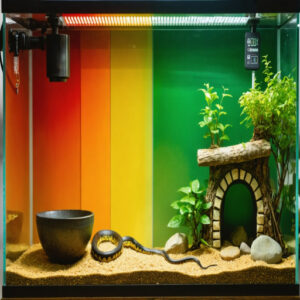This site is supported by our readers. We may earn a commission, at no cost to you, if you purchase through links.

You’ll need to monitor temperature gradients between 75-95°F depending on your species, maintain proper humidity levels, and provide fresh water every few days.
Monthly deep cleaning involves disinfecting all surfaces with reptile-safe cleaners and replacing substrate completely.
Don’t forget to calibrate your thermometers and hygrometers regularly—these instruments are your snake’s lifeline. Most keepers discover that consistent maintenance prevents costly health issues down the road.
Table Of Contents
- Key Takeaways
- Tank Setup Essentials
- Substrate Selection Guide
- Lighting and Heating Requirements
- Cleaning and Maintenance Schedule
- Health Monitoring and Hygiene Practices
- Frequently Asked Questions (FAQs)
- How to clean a snake tank?
- How often should you clean a snake tank?
- How do you keep a snake safe in a tank?
- Which product is best for cleaning a snake tank?
- How do I choose a snake tank?
- How long should a snake tank be?
- How often does a snake tank need to be cleaned?
- How to maintain a snake tank?
- How often should you change the bedding in a snake tank?
- How often should I mist my snakes tank?
- Conclusion
Key Takeaways
- You’ll need to establish proper temperature gradients between 75-95°F and maintain consistent humidity levels to prevent stress-related health issues in your snake.
- Daily spot-cleaning of waste and weekly substrate monitoring prevent bacterial growth, while monthly deep cleaning with reptile-safe disinfectants keeps your snake’s environment healthy.
- Regular calibration of your thermometers and hygrometers ensures accurate environmental readings, as these instruments are critical for maintaining your snake’s optimal living conditions.
- Consistent maintenance and care prevents costly veterinary bills by catching potential problems early, while proper substrate selection and depth support your snake’s natural behaviors like burrowing.
Tank Setup Essentials
Creating the perfect snake habitat starts with understanding your specific species’ needs and replicating their natural environment.
You’ll need to establish proper temperature gradients, microclimates, and appropriate terrarium sizing to guarantee your snake thrives in captivity.
Terrarium Size Based on Snake Species
Your snake’s terrarium size directly impacts its health and behavior.
Ball pythons need 40-gallon enclosures minimum, while corn snakes thrive in 20-gallon tanks initially.
Calculate enclosure dimensions using the two-thirds rule: tank length should equal two-thirds your snake’s body length.
Research species-specific habitat requirements before purchasing your terrarium to guarantee proper snake enclosure care.
For healthy snakes, consider the ball python size guidelines when setting up their enclosure.
Importance of Microclimates in Snake Tanks
Creating microclimates in your snake tank isn’t just fancy—it’s essential for your reptile’s health.
You’ll need distinct humidity zones and thermal gradients that mimic nature’s variety. Strategic placement of basking spots and cool retreats allows your snake to self-regulate temperature and behavior.
This environmental balance reduces stress while supporting natural activities like shedding and digestion. Understanding the importance of temperature requirements is vital for creating an ideal environment for your reptile.
Temperature Gradients for Thermal Regulation
Temperature gradients create thermal zones that let your snake self-regulate its body temperature—think of it as having air conditioning and heating in different rooms.
Position heat sources to establish basking spots at 90-95°F on the warm side, while maintaining cool areas at 78-80°F.
This gradient control supports proper digestion, immune function, and natural behaviors. Monitor these temperature zones with accurate thermometers for ideal thermal balance.
Substrate Selection Guide
You’ll find that selecting the right substrate is essential for your snake’s health and comfort.
The substrate you choose directly impacts humidity levels, odor control, and your snake’s natural behaviors like burrowing.
Natural Substrate Options for Snakes
Your substrate choice creates the foundation for your snake’s comfort and health.
Aspen shavings offer excellent odor control and easy spot cleaning, while cypress mulch works well for species needing higher humidity.
Coconut fiber and sphagnum moss provide natural moisture retention.
Reptile carpet simplifies maintenance but lacks burrowing opportunities.
Consider your snake’s natural environment when choosing substrate options.
For effective snake care, understanding aspen shavings benefits is essential for maintaining a healthy enclosure with proper odor control and moisture retention.
Humidity Control With Substrate Choice
Mastering humidity control through strategic substrate choice transforms your snake’s environment from basic to brilliant.
Your substrate depth directly affects moisture retention and ideal humidity levels:
- Sphagnum moss – Creates perfect humid hide conditions
- Coconut husk – Maintains steady moisture retention
- Cypress mulch – Ideal for high-humidity species
- 4-inch substrate depth – Supports natural burrowing behaviors
- Strategic placement – Position humidity probes mid-enclosure for accurate readings
The selection of substrate and its depth, along with strategic placement, are crucial for creating an optimal environment for your snake.
Lighting and Heating Requirements
You’ll need to create proper lighting and heating systems to keep your snake healthy and comfortable. Getting the temperature gradients right is essential for your snake’s digestion and overall well-being.
Nocturnal Snake Lighting Needs
Your snake doesn’t need bright lighting like a sun-worshipping lizard.
Most nocturnal species thrive with a simple 12-hour light cycle using standard fluorescent bulbs, then complete darkness at night.
Skip the fancy UVB lighting unless you’re housing diurnal species.
Night bulbs and colored lights still disrupt their natural rhythms, so embrace the darkness your snake craves.
Temperature Control With Heating Pads
Under-tank heating pads serve as your primary heat sources for creating proper temperature gradients in snake enclosures.
Position these heating elements under one-third of your tank’s floor to establish effective heat distribution and thermal regulation. This pad placement creates a warm basking area while maintaining cooler zones for your snake’s comfort.
Always use a thermostat with undertank heating pads to prevent overheating and guarantee consistent snake tank temperature control throughout the day.
When selecting heating pads, consider the quality of heating pad materials to guarantee safe and efficient heating pad solutions.
Thermometer Placement for Accurate Readings
Strategic thermometer placement makes or breaks your temperature control system.
Smart thermometer placement determines whether your snake thrives or struggles with temperature stress.
Position digital thermometers at substrate level in both warm and cool zones for accurate thermal gradient readings.
Place humidity probes mid-enclosure to avoid skewed moisture levels.
Check sensor placement monthly—loose probes give false readings that’ll mess up your heat source adjustments.
Calibrate thermometers quarterly to maintain precision in temperature monitoring and guarantee your reptile’s comfort zone stays spot-on.
Understanding proper temperature control methods is vital for creating a healthy environment for your snake, and using digital thermometers and humidity probes correctly is key to achieving this, with accurate thermal gradient readings and precise temperature monitoring being crucial, and ensuring the system is not compromised by false readings.
Cleaning and Maintenance Schedule
A clean snake tank prevents bacterial growth, respiratory infections, and skin problems that can seriously harm your pet.
You’ll need to balance regular spot cleaning with deeper maintenance to keep your snake healthy without over-stressing them by removing familiar scents.
Spot Cleaning Vs. Full Tank Cleaning
Your cleaning approach determines your snake’s health and your time investment.
Daily spot cleaning prevents bacterial growth and maintains hygiene, while weekly deep cleaning guarantees thorough waste disposal and stress reduction.
Here’s your cleaning frequency guide:
- Daily spot cleaning – Remove feces immediately using disposable gloves and cleaning tools
- Weekly tank cleaning – Wipe down glass, replace soiled substrate sections
- Monthly deep cleaning – Complete substrate change and accessory washing
- Water bowl maintenance – Clean and refill every few days
- Equipment checks – Inspect heating elements during deep cleans
This balanced approach maximizes hygiene importance while minimizing disruption to your snake’s routine.
Regular Cleaning Schedule for Snake Tanks
Following your template, you’ll want to stay consistent with your cleaning routine. Daily Spot Cleaning removes waste immediately, preventing bacterial growth. Weekly Deep Cleaning involves full Tank Sanitizing and Water Bowl Maintenance. Monthly Substrate Replacement keeps things fresh.
Here’s your snake tank cleaning schedule:
Regular maintenance also involves understanding tank maintenance tips to guarantee a healthy environment.
| Frequency | Tasks | Tools Needed |
|---|---|---|
| Daily | Waste removal, water refill | Tongs, paper towels |
| Weekly | Surface wiping, decor cleaning | Disinfectant, brushes |
| Monthly | Full substrate change | Cleaning Tools, fresh bedding |
Safe Cleaning Agents for Snake Enclosures
You’ll want to protect your scaly friend from harsh chemicals that can irritate their sensitive skin.
Chlorhexidine stands out as the gold standard reptile safe disinfectant, recommended by veterinarians for effective snake tank sanitization without toxic residues.
For chemical alternatives, antibacterial soap offers a gentler cleaning option, while diluted bleach works but requires thorough rinsing.
Your tank cleaning routine should prioritize reptile safety over convenience—skip household cleaners that contain ammonia or phenols, as these pose serious chemical sensitivity risks for your snake.
When selecting a disinfectant, consider using a reptile safe disinfectant reptile care products to guarantee the health and well-being of your pet.
Health Monitoring and Hygiene Practices
You can’t maintain a healthy snake without monitoring its health and practicing proper hygiene in the tank.
Regular health checks and preventative care help catch problems early, while clean tank conditions prevent respiratory infections and skin issues that plague neglected reptiles, which is crucial for maintaining a healthy environment and preventing issues such as respiratory infections.
Feeding Schedule for Optimal Nutrition
Proper feeding frequency creates the foundation for your snake’s health—juveniles need meals every 5-7 days, while adults thrive on 10-14 day intervals.
Your snake’s carnivorous diet requires appropriately sized prey (never exceeding 1.5 times their body width) to prevent digestive issues.
Varying food options between mice, rats, and chicks ensures optimal nutrient balance throughout their feeding schedule.
Understanding the vital snake feeding schedule is essential for maintaining healthy reptiles, and following a proper feeding frequency guide helps prevent digestive problems.
Monitoring Snake Health for Behavioral Changes
You’ll spot trouble before it becomes serious by watching your snake’s daily habits.
Active snakes with regular tongue flicking show good health, while lethargy or excessive hiding signals problems.
Monitor feeding patterns carefully—appetite loss often indicates illness.
Watch for respiratory issues like open-mouth breathing or discharge.
Document weight changes and shedding cycles to catch health problems early.
Preventative Care With Regular Vet Visits
Schedule veterinary care every 6-12 months for thorough snake health checks.
Your reptile-savvy vet will perform preventative measures including weight monitoring, parasite screenings, and shed assessments.
Regular exams catch potential issues before they become serious problems, think of veterinary care as your snake’s annual wellness report card – these health checks keep your scaly friend thriving long-term, with regular exams and preventative measures.
Frequently Asked Questions (FAQs)
How to clean a snake tank?
While dirty tanks breed bacteria and stress, clean enclosures promote health and comfort. You’ll spot-clean daily for droppings, perform weekly wipe-downs with chlorhexidine, and deep-clean monthly by replacing substrate completely.
How often should you clean a snake tank?
You’ll need to spot clean your snake tank daily to remove waste and replace soiled substrate. Complete deep cleaning should happen monthly, including washing all accessories and replacing substrate entirely.
How do you keep a snake safe in a tank?
Maintain proper temperature gradients with thermostats, provide secure hiding spots, guarantee adequate ventilation, use appropriate substrate depth, and regularly monitor your snake’s behavior for signs of stress or illness.
Which product is best for cleaning a snake tank?
Chlorhexidine stands out as the top cleaning product for your snake’s enclosure.
Veterinarians recommend this antibacterial solution because it’s effective yet gentle on reptiles.
You’ll find it kills harmful bacteria without leaving toxic residues that could harm your snake’s health, making it a great choice for maintaining a clean and healthy environment.
How do I choose a snake tank?
Choose your snake tank by matching species requirements: ball pythons need 40-gallon minimum, corn snakes need 20-gallon. Tank length should be two-thirds your snake’s length for proper movement and comfort.
How long should a snake tank be?
Giant enclosures aren’t always better—smaller spaces can stress snakes.
You’ll want your tank to be at least two-thirds your snake’s length.
Ball pythons need 40-gallon tanks minimum, while corn snakes thrive in 20-gallon setups.
How often does a snake tank need to be cleaned?
You’ll need to spot clean your snake tank daily to remove waste and soiled substrate. Deep clean monthly by replacing all substrate and disinfecting surfaces with chlorhexidine solution.
How to maintain a snake tank?
Maintain your snake’s habitat by spot-cleaning daily, replacing substrate monthly, and monitoring temperature gradients. You’ll need proper ventilation, humidity control, and regular equipment checks for peak health.
How often should you change the bedding in a snake tank?
Replace bedding every 1-2 months for ideal snake health. You’ll need spot cleaning daily for waste, but complete substrate changes depend on your snake’s species and enclosure conditions.
How often should I mist my snakes tank?
Like a gentle morning dew, misting shouldn’t be your daily routine.
You’ll want to mist only when humidity drops below 50% or during shedding periods, typically every few days to weekly depending on your snake’s species and environmental conditions.
Conclusion
Following your snake tank maintenance guide transforms your reptile’s environment from a mere enclosure into a thriving sanctuary.
You’ll discover that consistent daily spot-cleaning, weekly substrate monitoring, and monthly deep cleaning create the foundation for your snake’s long-term health.
Regular temperature and humidity checks prevent stress-related illnesses before they develop.
Your thermometer and hygrometer calibration guarantees accurate environmental readings.
Most importantly, you’ll find that proactive maintenance saves money on veterinary bills while keeping your snake comfortable and healthy.
- https://www.oxyfresh.com/blogs/pet-health/snake-terrariums-101-your-guide-to-safe-cleaners
- https://www.reddit.com/r/ballpython/comments/14nxtid/how_often_do_you_deep_clean_your_enclosures/
- https://aminoapps.com/c/reptiles/page/item/how-to-clean-your-snake-enclosure/WJdV_d3rIVIL0gVNXN374Ra885WlveZEd6w
- https://www.jabberwockreptiles.com/news/ball-python-temperature/
- https://community.morphmarket.com/t/humidity-levels/40133













